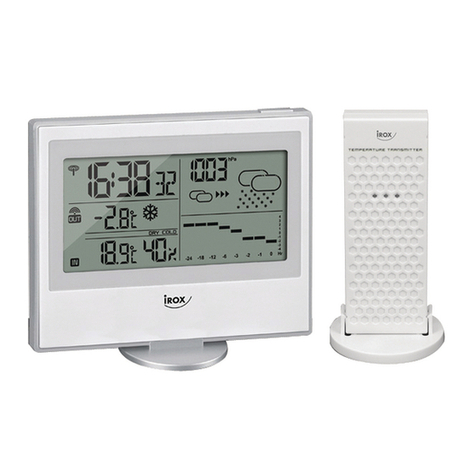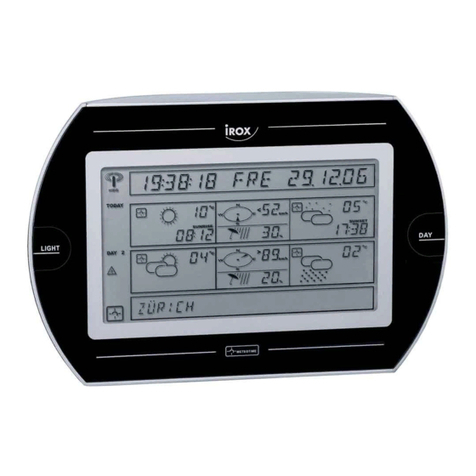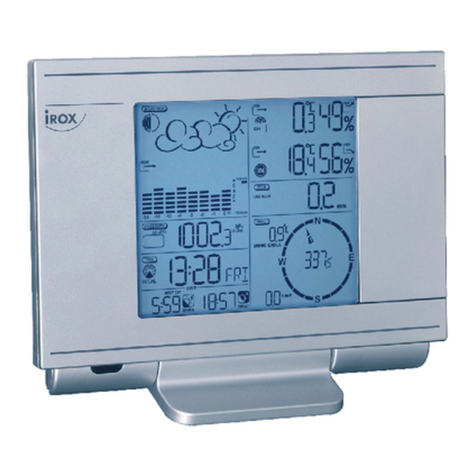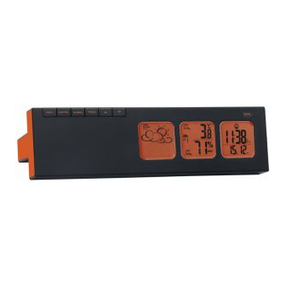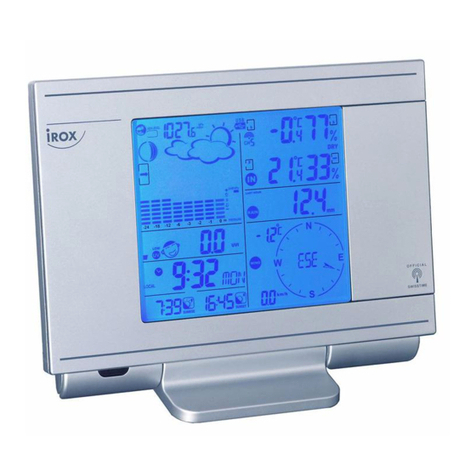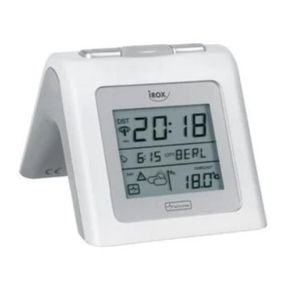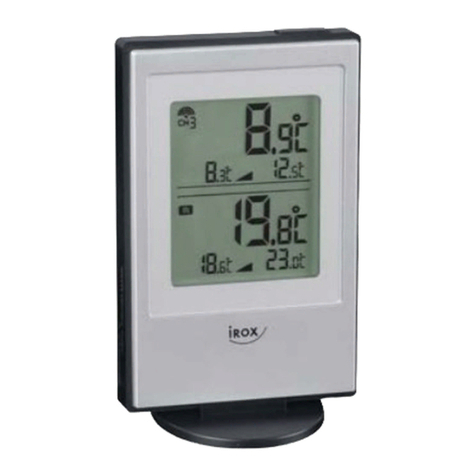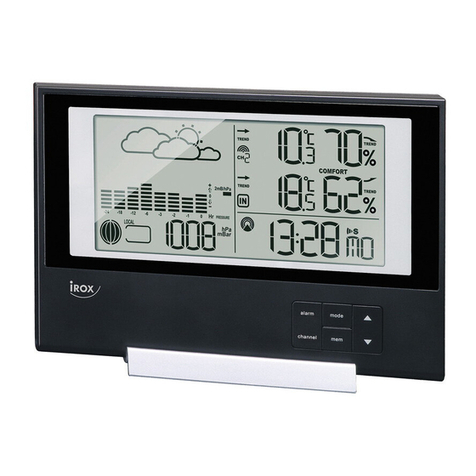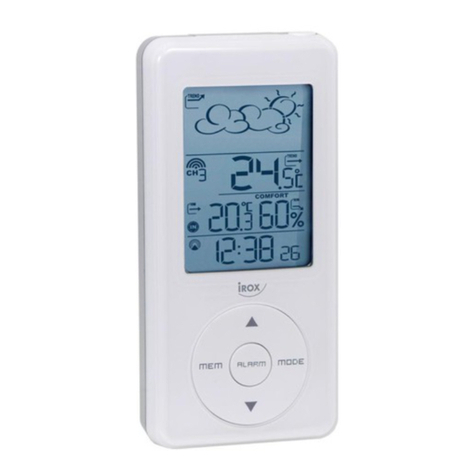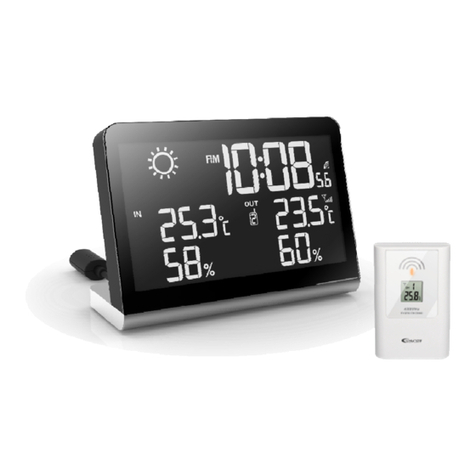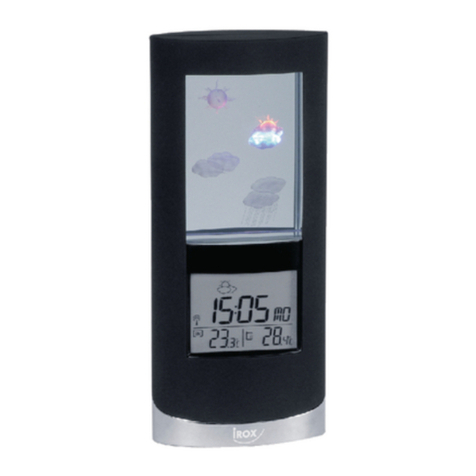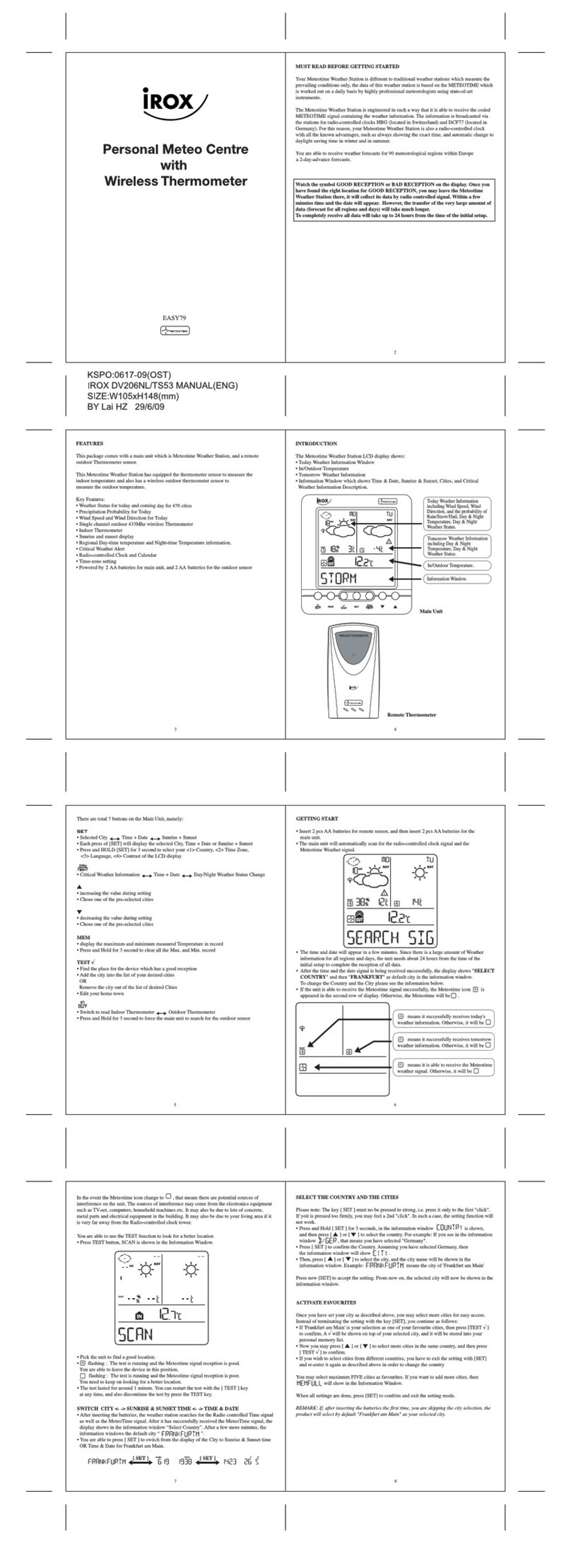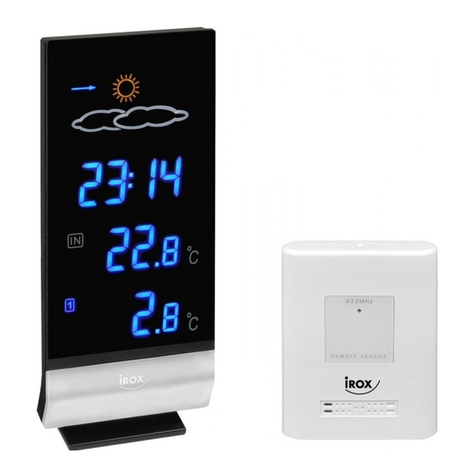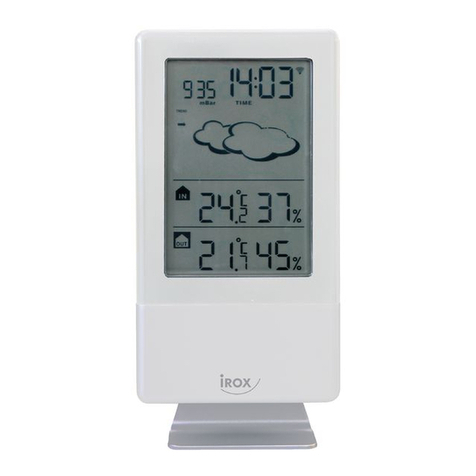KSPO: 0813-09
IROX OST13-MANUAL(Eng)
SIZE:W100 x H100(mm)
BY Lai HZ 21/7/09
JKT-3R
Version 1.1
Page 29
Page 30
Page 30
Page 31
Page 33
Page 34
Page 36
Page 36
Page 36
Page 37
Page 37
Page 38
Page 38
Page 39
Operating Instructions
Table of contents
1. Introduction
2. Operating elements
2.1 LCD display
2.2 Keys / Switch / Battery compartment
3. Putting into operation
4. Radio thermometer
5. Operation
5.1 Thermometer
5.1.1 Reading of the temperature from each channel
5.1.2 MIN/MAX memory
6. Change of battery
7. Care instructions
8. Support
9. Technical data (display unit)
1. INTRODUCTION
Instruments by Jörg Kachelmann
Jörg Kachelmann, meteorologist and founder of Meteomedia AG, revolutionised weather
reports in the early 90ies with a new type of media presentation and the high quality of his local
weather forecasts.
Today Meteomedia is one of the leading weather services in Europe and, with its own Severe
Weather Centres in Switzerland and in Germany, among other things, specialist for modern
early warning systems for extreme weather conditions.
The core of the company is the private weather measurement network. It is one of the biggest
measurement networks in Europe.
With "Instruments by Jörg Kachelmann" Irox, market leader in the manufacturing of measuring
devices, and Jörg Kachelmann have developed a joint product that convinces with its high
quality measurements, simple handling and elegant design.
Weather forecasts by Jörg Kachelmann: www .meteocentrale.ch
The JKT-3R is a high-quality thermometer that gives you the absolutelyunique feature
of choosing between three different max/min memory functions. The recording is done
independently for each of the6 channels in total. The individual scanning of the 5 radio
sensors also makes operation transparent and calculable.
Please read the instructions carefully. They contain some useful and interesting information that
go beyond a mere explanation of how to operate the device.
2. OPERATING ELEMENTS
2.1 LCD DISPLAY
All functions are depicted on the liquid crystal display (LCD) in 3 windows.
Full-segment display
Radio channels 1-5:
- current measurement of the selected channel (=radio probe)
- memory values min/max of the selected channel
- battery status of the sender displayed
Indoor thermometer :
- temperature of the display device (measures at the location where the device is used)
(1 2 3 4 5 1 etc)
- memory values min/maxof the indoor thermometer
- battery status of the display device
2.2 KEYS / SWITCH / BATTERY COMPARTMENT
Rear view
°C/°F
- Changes the unit of temperature in the display from °C to °F or vice versa
MEMORY RESET
- Hold pressed for 3 seconds: Resets all memories (IN and CH1 ... CH5). The new recording
now begins depending on the setting of the MIN-MAX switch
CH
(=CHANNEL)
- Press briefly: changes to display of the next channel
- Hold pressed for 3 seconds. For the radio channel active on the display (CH1 .... CH5),
a sender search is started. The three waves above the CH flash during the search process.
Only the sender of the channeldisplayed is searched for; the others remain unaffected.
MIN-MAX
The MIN/MAX memory is managed and recorded dependingon the setting. The setting applies
for all 6 channels
Pos. 1: PERM - From the last MEMORY RESET, the MIN/MAX recordingsafter the function
“drag indicator” are recorded. This recordingis "PERMANENT", i.e. a new recording
does not start until after a new MEMORY reset.
Pos. 2: 24 Hr - If you choose this option, the MIN/MAX values for the last 24-28 hours in each
case are recorded. After expiry of this period, the MIN/MAX values that are olderthan
24-28 hours are removed from the memory. As soon as you have selected this option,
we recommend that you start the memory recording in a defined way with a
MEMORY RESET. This then starts a recording that triggers internally an elaborate
calculation and recording. The MIN/MAX values areadministered here in blocks of four
hours.
Example: You want to be able to read the MIN/MAX values of the last 24-28 hours at all
times. Irrespective of when you look at the display, you will always see the extreme
values of the last 24-28 hours. Older recordings are deleted in the process.
Pos. 3: DAY- If you select this option,the MIN/MAX values are recorded for 24 hours in each
case. You are free to choose when the recording should begin. The start is determined
by a MEMORY RESET and after 24 hours, the memoryis automatically reset and a new
recording begins. Example: You want to be ableto read the MIN/MAX values of the last
24 hours in each case at 8 p.m. You therefore carry out a MEMORY RESET at 8 p.m.
With this RESET, the clock begins to tick internally and this automatically resets the
memory after 24 hours and starts a new recording.
Battery compartment
2 x 1.5 batteries of the size AM-4 resp. “AAA”
To open: slide lid in the direction of the arrow (indicated onthe lid) after the stand has been
removed.
3. PUTTING INTO OPERATION
1. Put all radio sensors that you want to use into operation and place these in close proximity
(1-2 metres) to the reception device.
2. Open the battery compartment of thedisplay device and remove all insulation strips. If no
batteries are in the device, insert the 2 batteries (UM-3 or ‘AA’ 1.5 V) in the correct polarity.
3. Now close the battery compartment.
4. Directly after the activation of the batteries, all segmentsare displayed for a few seconds on
the display. The JKT-3R then begins with the search of available sensors onall 5 channels.
5. As soon as the sensor is displayed correctly (see ‘Receptionstatus’ in Chap., 4), you can set
up the sensor in the place where you want to effectively measure the outdoor temperature.
Under the most ideal conditions, this can be up to 30 m away. In reality, however, this is often
less. In the event of problems, try out otherplaces, and do so both for the sensor and for the
display device. The radio sensor is weatherproof. Nevertheless, please place the sensor
where possible in the dry and at any rate in the shade.
6. If you would like to display further sensors on the reception device, you can purchase these
from shops. For outdoor use, we recommend weatherproof sensors. Ifyou would like to
display other interior spaces, the sensor JKR-1 from the ‘Instruments by Jörg Kachelmann’
range is available in the same design as that of the display device and also has a large
display.
The unit is in searching mode.
Temperature readings are
securely registered.
No signals.
4. RADIO THERMOMETER
The operation of the radio sensor supplied with the device iseasy:
- Open battery compartment
- Select channel
- Activate batteries (i.e. remove insulation strip) or insert batteries (please make sure that the
polarity is correct!)
- Close battery compartment again (please ensure that it is tightly closed!)
Other Irox radio sensors that are compatible with the JKT-3R:
3 channels (can be used on the channels, 1, 2 or 3) : HTS12C, HTS33, HTS13*, HTC13
5 channels (can be used on all5 channels): HTS55, JKR-1
(*HTS13 is included in the scope of delivery of the JKT-3R and can be used on the
channels 1-3)
With the sensors with thermo and hygrometer, simply only the temperature is displayed on the
JKT-3R.
Reception status display
The wave symbol indicates the status of the signal reception of the channel displayed.
281
3029
3231
3433












